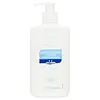What's inside
What's inside
 Key Ingredients
Key Ingredients

 Benefits
Benefits

 Concerns
Concerns

 Ingredients Side-by-side
Ingredients Side-by-side

Water
Skin ConditioningHydroxyethyl Urea
HumectantGlycerin
HumectantDimethicone
EmollientJojoba Esters
EmollientPetrolatum
EmollientSelaginella Lepidophylla Extract
EmollientAloe Barbadensis Leaf Juice
Skin ConditioningStearyl Alcohol
EmollientBehentrimonium Methosulfate
Glyceryl Stearate
EmollientSteareth-21
CleansingCetyl Alcohol
EmollientButylene Glycol
HumectantStearamidopropyl Pg-Dimonium Chloride Phosphate
Propylene Glycol
HumectantCetearyl Alcohol
EmollientPolysorbate 60
EmulsifyingCitrullus Lanatus Fruit Extract
Skin ConditioningPyrus Malus Fruit Extract
Skin ConditioningLens Esculenta Fruit Extract
Skin ConditioningSodium Lactate
BufferingSodium PCA
HumectantDistearyldimonium Chloride
Methyl Gluceth-20
HumectantEthylhexylglycerin
Skin ConditioningMethylparaben
PreservativeTocopheryl Acetate
AntioxidantBisabolol
MaskingZingiber Officinale Root Extract
MaskingPanthenol
Skin ConditioningHydrolyzed Jojoba Esters
Skin ConditioningEDTA
Ubiquinone
AntioxidantC12-15 Alkyl Benzoate
AntimicrobialJojoba Oil/Macadamia Seed Oil Esters
Skin ConditioningSqualene
EmollientPhytosteryl Macadamiate
Skin ConditioningPhytosterols
Skin ConditioningTocopherol
AntioxidantPotassium Hydroxide
BufferingMagnesium Ascorbyl Phosphate
AntioxidantWhey Protein
Skin ConditioningWater, Hydroxyethyl Urea, Glycerin, Dimethicone, Jojoba Esters, Petrolatum, Selaginella Lepidophylla Extract, Aloe Barbadensis Leaf Juice, Stearyl Alcohol, Behentrimonium Methosulfate, Glyceryl Stearate, Steareth-21, Cetyl Alcohol, Butylene Glycol, Stearamidopropyl Pg-Dimonium Chloride Phosphate, Propylene Glycol, Cetearyl Alcohol, Polysorbate 60, Citrullus Lanatus Fruit Extract, Pyrus Malus Fruit Extract, Lens Esculenta Fruit Extract, Sodium Lactate, Sodium PCA, Distearyldimonium Chloride, Methyl Gluceth-20, Ethylhexylglycerin, Methylparaben, Tocopheryl Acetate, Bisabolol, Zingiber Officinale Root Extract, Panthenol, Hydrolyzed Jojoba Esters, EDTA, Ubiquinone, C12-15 Alkyl Benzoate, Jojoba Oil/Macadamia Seed Oil Esters, Squalene, Phytosteryl Macadamiate, Phytosterols, Tocopherol, Potassium Hydroxide, Magnesium Ascorbyl Phosphate, Whey Protein
Water
Skin ConditioningGlycerin
HumectantCaprylic/Capric Triglyceride
MaskingCetearyl Alcohol
EmollientBehentrimonium Methosulfate
Ceteareth-20
CleansingCeramide NP
Skin ConditioningCeramide EOP
Skin ConditioningSodium Hyaluronate
HumectantCholesterol
EmollientDimethicone
EmollientPolysorbate 20
EmulsifyingPolyglyceryl-3 Diisostearate
EmulsifyingPotassium Phosphate
BufferingDipotassium Phosphate
BufferingSodium Lauroyl Lactylate
EmulsifyingCetyl Alcohol
EmollientDisodium EDTA
Phytosphingosine
Skin ConditioningIodopropynyl Butylcarbamate
PreservativeBenzyl Alcohol
PerfumingCarbomer
Emulsion StabilisingXanthan Gum
EmulsifyingWater, Glycerin, Caprylic/Capric Triglyceride, Cetearyl Alcohol, Behentrimonium Methosulfate, Ceteareth-20, Ceramide NP, Ceramide EOP, Sodium Hyaluronate, Cholesterol, Dimethicone, Polysorbate 20, Polyglyceryl-3 Diisostearate, Potassium Phosphate, Dipotassium Phosphate, Sodium Lauroyl Lactylate, Cetyl Alcohol, Disodium EDTA, Phytosphingosine, Iodopropynyl Butylcarbamate, Benzyl Alcohol, Carbomer, Xanthan Gum
 Reviews
Reviews

Ingredients Explained
These ingredients are found in both products.
Ingredients higher up in an ingredient list are typically present in a larger amount.
Behentrimonium Methosulfate is an ammonium salt. It is mainly used to prevent static in haircare products as a surfactant.
Surfactants have differing ends: one side is hydrophilic while the other end is hydrophobic.
Surfactants also help your cleansers remove pollutants more easily from the skin.
Learn more about Behentrimonium MethosulfateCetearyl alcohol is a mixture of two fatty alcohols: cetyl alcohol and stearyl alcohol. It is mainly used as an emulsifier. Emulsifiers help prevent the separation of oils and products. Due to its composition, it can also be used to thicken a product or help create foam.
Cetearyl alcohol is an emollient. Emollients help soothe and hydrate the skin by trapping moisture.
Studies show Cetearyl alcohol is non-toxic and non-irritating. The FDA allows products labeled "alcohol-free" to have fatty alcohols.
This ingredient is usually derived from plant oils such as palm, vegetable, or coconut oils. There is debate on whether this ingredient will cause acne.
Due to the fatty acid base, this ingredient may not be Malassezia folliculitis safe.
Learn more about Cetearyl AlcoholCetyl Alcohol is a fatty alcohol. Fatty Alcohols are most often used as an emollient or to thicken a product.
Its main roles are:
Though it has "alcohol" in the name, it is not related to denatured alcohol or ethyl alcohol.
The FDA allows products labeled "alcohol-free" to have fatty alcohols.
Learn more about Cetyl AlcoholDimethicone is a type of synthetic silicone created from natural materials such as quartz.
What it does:
Dimethicone comes in different viscosities:
Depending on the viscosity, dimethicone has different properties.
Ingredients lists don't always show which type is used, so we recommend reaching out to the brand if you have questions about the viscosity.
This ingredient is unlikely to cause irritation because it does not get absorbed into skin. However, people with silicone allergies should be careful about using this ingredient.
Note: Dimethicone may contribute to pilling. This is because it is not oil or water soluble, so pilling may occur when layered with products. When mixed with heavy oils in a formula, the outcome is also quite greasy.
Learn more about DimethiconeGlycerin is already naturally found in your skin. It helps moisturize and protect your skin.
A study from 2016 found glycerin to be more effective as a humectant than AHAs and hyaluronic acid.
As a humectant, it helps the skin stay hydrated by pulling moisture to your skin. The low molecular weight of glycerin allows it to pull moisture into the deeper layers of your skin.
Hydrated skin improves your skin barrier; Your skin barrier helps protect against irritants and bacteria.
Glycerin has also been found to have antimicrobial and antiviral properties. Due to these properties, glycerin is often used in wound and burn treatments.
In cosmetics, glycerin is usually derived from plants such as soybean or palm. However, it can also be sourced from animals, such as tallow or animal fat.
This ingredient is organic, colorless, odorless, and non-toxic.
Glycerin is the name for this ingredient in American English. British English uses Glycerol/Glycerine.
Learn more about GlycerinWater. It's the most common cosmetic ingredient of all. You'll usually see it at the top of ingredient lists, meaning that it makes up the largest part of the product.
So why is it so popular? Water most often acts as a solvent - this means that it helps dissolve other ingredients into the formulation.
You'll also recognize water as that liquid we all need to stay alive. If you see this, drink a glass of water. Stay hydrated!
Learn more about Water